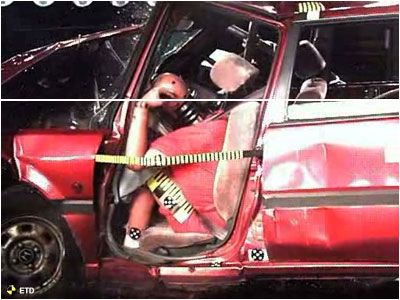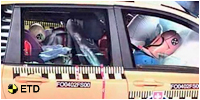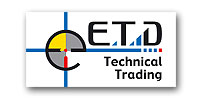|
|
 |
|
|
Crash-Test News |
|
|
| |
|
|
| |
It is constantly being reported in ADACmotorwelt (ADAC Motor World) that crash tests are vitally important:
In June 2004 ADAC carried out two frontal crash tests between an off-road vehicle and a smaller, lighter vehicle. This test was conducted as early as November 1993, and in it all the occupants died in the simulated accident. However, this year’s test showed that much has been done both in terms of driver and passenger protection and also with regard to smaller passenger cars, and that the risk of injury is far lower than eleven years ago.
Even during the Euro-NCAP crash test programme several passenger cars again collided. Here it was shown in the frontal, side crash, post test and tests for pedestrian and child protection, how high the risk of injury among road users can be, and that our cars are becoming increasingly safe. Major progress is being made in the area of active safety in small cars (ADACmotorwelt 12/04 reports, for example, on Renault Mode in daily newspapers/the technical journal Autobild, on smart GmbH and its safe car smart fortwo).
Class S driving licence from the age of 16:
Since February 2005 youths from age 16 up may also drive a mini-car in this country – with a Class S driving licence up to 45 km/h.
However, the test results in this sector are disastrous: ADACmotorwelt 12/04 reports on one of these tests, with the result that a mini-car and its occupants are horribly injured in the event of an accident – the same applies to light vehicles such as quad bikes (four-wheel motor scooters). Further tests and developments are urgently required here.
Please see detailed results at www.adac.de under Tests.
The accident statistics also show a positive trend in terms of chances
of survival notwithstanding an increase in vehicle density. However, thousands are still drying or are severely injured in road traffic accidents despite improved technology.
The continuous collaboration (research and development) between the crash test institutions, the manufacturers of electronic test units and the supply industry, is resulting in an improvement in body structure and hence a reduction in the risk of occupant injury. A stable, resistant passenger cell, airbags, well designed restraining systems, headrests, additional safety systems such as belt alarms, on-call system, but also the type and design of the interior fittings, may spell survival in an emergency.
You may access the individual up to date test reports via the ADAC link www.adac.de/Test/Crash_Test
The Gesamtverband Deutscher Versicherer (GDV) (General Federation of German Insurers) is also fighting for road safety and regularly issues reports on its home page www.gdv.de. The latest media reports (among others ADACmotorwelt, GDV) show, for example, how important high quality headrests are.
You can read about the crash test data and test procedures, incl. injury risk, via the EuroNCAP link (www.euroncap.com). A maximum best score of 5 stars is awarded. For the consumers the crash tests are a reliable source of information when purchasing a car and they encourage the manufacturers to build safer cars. EuroNCAP standards the European New Car Assessment Program, whose task is to carry out uniform crash tests (laterally displaced against a deformable barrier at 64 km/h), side crash (deformable barrier rams the car laterally at 48 km/h), post test (the car is crashed at 30 km/h against a steel column) and test series for different pedestrian crashes at 40 km/h.
One of the world leaders in the manufacturer of automotive and passive safety systems is Autoliv. Examples of these are occupant protection systems (seat belts, airbags, gas generators, electronic systems (night vision and emergency call system) and seat structures) and pedestrian protection systems.
A new achievement in this sector is the collision airbag in the form of an inflatable curtain, developed to reduce the risk of injury in the event of rollover accidents.
You may obtain more information at www.autoliv.de /-> products.
DEKRA is also conducting research to increase road traffic safety.
Accident tests and the scientific knowledge gained from them contribute to the steady improvement in life-saving safety standards.
You will find more details on the subject of crash tests and their assessments and accident research via the DEKRA links (branch dealing with crash tests and accident research, vehicle homologation, research and development).
We should like to thank all contributors and the following companies for their kind support and the supply of links, film and photographic material.

|
|
| |
|
|
| |
|
|
|
|
|
|
|
|


















